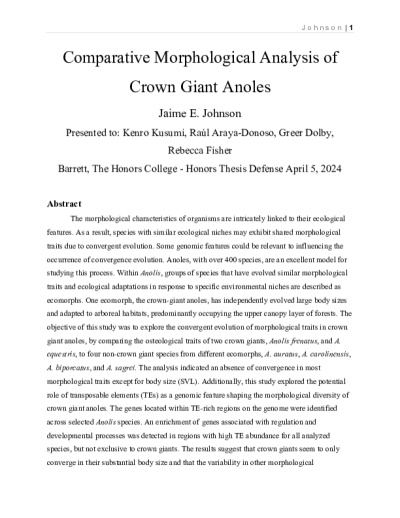
Heat shock factors (HSFs) are transcriptional regulators that play a crucial role in the cellular response to environmental stress, particularly heat stress. Understanding the evolution of HSFs can provide insights into the adaptation of organisms to their changing environments. This project explored the evolution of HSFs within tetrapods, a group of animals that includes amphibians, reptiles, turtles, and mammals. Through an analysis of the available genomic data and subsequent genomic methodologies, HSFs have undergone significant changes throughout tetrapod evolution, as evidenced by loss events observed in protein sequences of the species under examination. Moreover, several conserved and divergent regions within HSF proteins were identified, which may reflect functional differences between HSFs in different tetrapod lineages. Our findings suggest that the evolution of HSFs has contributed to the adaptation of tetrapods to their diverse environments and that further research on the functional and regulatory differences between HSFs may provide a better understanding of how organisms cope with stress in heat-stressed environments.
Our bodies are constantly fighting off viral pathogens both with our external barriers such as skin as well as internally through the immune system. Mucin genes specifically Muc5AC and Muc5B help assist in this process by activating both bacterial and mucus pathogenesis. Their gene expression is correlated with temperature meaning that in warmer temperatures they have decreased expression. Developing a better understanding of their functionality as well as their expression can help species that are in danger of becoming extinct.
Understanding learning in fruit flies (D. melanogaster) can lead to many important discoveries about learning in humans due to the large overlap of shared DNA and the appearance of the same diseases in both species. Fruit flies have already been test subjects for many influential research experiments, some of which earned Nobel Prizes. This study seeks to investigate inhibitory conditioning in a way that differs from the traditional forward pairing inhibitory conditioning. Specifically, this experiment aims to establish inhibitory learning in fruit flies using backward association. The results show that when fruit flies are trained using backward conditioning as opposed to forward conditioning, there is a pattern of preference that differs substantially from the results showing an aversion to the associated odor in forward conditioning. When comparing the data using Two-Factor ANOVA of forward versus backward conditioning, it clearly indicates that the results are significant. Simply by altering the temporal placement of an unconditioned stimulus and a conditioned stimulus, the fruit flies learn significantly differently, switching from an aversion to the paired odor to a preference. Based on these results, fruit flies can be considered capable of inhibitory learning via backward pairing. Further research will consider whether responses become stronger after more repetitions of the training, and summation and retardation tests can be done in order to confirm that the response is, in fact, due to inhibitory conditioning and not just habituation.
In the face of widespread pollinator decline, research has increasingly focused on ways that pesticides could be harming bees. Fungicides are pesticides that are used in greater volumes than insecticides, yet significantly fewer studies have investigated the effects of these agrochemicals. The fungicide Pristine® is commonly used on bee-pollinated crops and has been shown to be detrimental to physiological processes that are key to honey bee foraging, such as digestion and learning. This study seeks to investigate how Pristine® exposure affects the amount of water, nectar, and pollen that honey bees collect. Colonies were fed either plain pollen patties or pollen patties containing 23 ppm Pristine®. Exposure to fungicide had no significant effect on corbicular pollen mass, the crop volumes of nectar or water foragers, or the proportions of foragers collecting different substances. There was a significantly higher sugar concentration in the crop of Pristine®-exposed nectar foragers (43.6%, 95% CI [38.8, 48.4]) compared to control nectar foragers (36.3%, 95% CI [31.9, 40.6]). The higher sugar concentration in the nectar of Pristine®-treated bees could indicate that the agrochemical decreases sucrose responsiveness or nutritional status in bees. Alternatively, fungicide exposure may increase the amount of sugar that bees need to make it back to the hive. Based on these results, it would appear that fungicides like Pristine® do not strongly affect the amounts of substances that honey bees collect, but it is still highly plausible that treated bees forage more slowly or with lower return rates.



